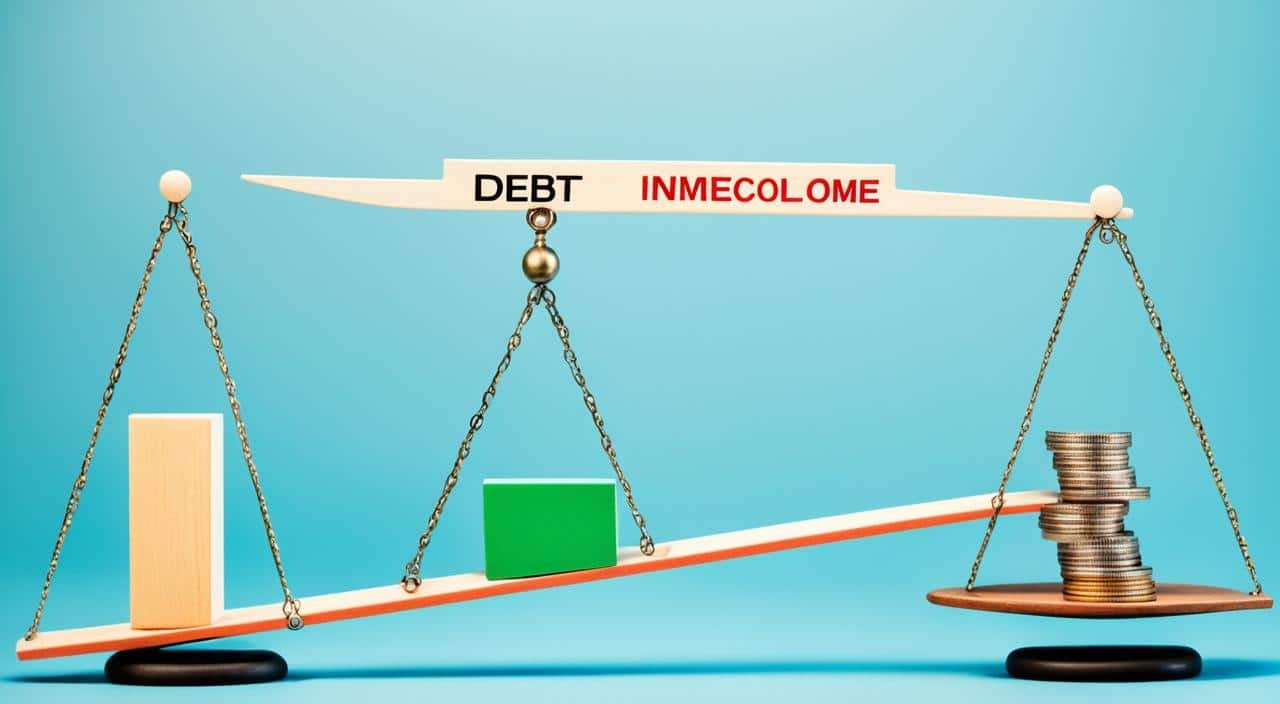Getting a mortgage loan might seem complex and scary, but it’s easier than you think. By knowing the main steps, you can feel more confident as you go through the process. The mortgage process has several stages, from improving your credit to finding the right lender and signing the final papers. Let’s look at how to get a mortgage loan step by step.
Key Takeaways
- The mortgage process involves several stages, including pre-approval, house shopping, mortgage application, loan processing, underwriting, and closing.
- Improving your credit score and debt-to-income ratio can increase your chances of securing a favorable mortgage loan.
- Determining your affordability and building sufficient savings are crucial steps in the mortgage process.
- Exploring different mortgage loan types, rates, and terms can help you find the best fit for your financial situation.
- Working with a reputable mortgage lender and getting pre-approved can streamline the home buying process.
Strengthening Your Credit Score
Before you apply for a mortgage, make sure to improve your credit score. A higher score means better loan terms and lower interest rates. Focus on these key areas to boost your credit history:
Monitor Your Credit Report
Check your credit report from Experian, Equifax, and TransUnion often. Look for any mistakes that could lower your credit score. If you find errors, correct them with the credit bureaus right away.
Reduce Credit Card Balances
Your credit card use ratio is a big part of your credit score. Try to keep your balances under 30% of your total limit. Paying down your credit card debt regularly will help improve this important credit factor.
Maintain a Positive Payment History
Your payment history is key to your credit score. Always pay your credit card and loan bills on time. Stay away from past-due accounts and credit errors to keep your credit report strong.
By improving your credit score before applying for a mortgage, you’ll get the best loan terms. This makes the approval process smoother.
Also Read :What Scholarships Does Duke University Offer?
Determining Your Affordability

Buying a home requires careful thought about what you can afford. The debt-to-income (DTI) ratio is a key tool for this. It shows how much house you can afford by comparing your monthly debt to your income.
Calculating Debt-to-Income Ratio
To figure out your DTI ratio, just follow these steps:
- Add up all your monthly debt payments, like your mortgage, car loans, student loans, and credit card minimums.
- Then, divide that total by your gross monthly income, which is your earnings before taxes and deductions.
- The percentage you get is your DTI ratio.
For instance, if your monthly debt is $2,000 and your income is $6,000, your DTI ratio is 33.33% ($2,000 / $6,000 = 0.3333 or 33.33%).
| Debt-to-Income Ratio | Mortgage Eligibility |
|---|---|
| Less than 36% | Typically considered a good DTI ratio for most mortgage lenders |
| 36% to 43% | May still be eligible for a mortgage, but with potentially higher interest rates or stricter requirements |
| Above 43% | Mortgage lenders may be less likely to approve your loan application |
Think about more than just your mortgage payment. Consider utilities, groceries, and transportation costs too. A low DTI ratio helps you avoid being “house poor,” where your mortgage takes too much of your budget.
By figuring out your DTI ratio and looking at your finances, you can set a realistic budget. This ensures your home fits your financial plans for the future.
Also Read :What Different Types Of Loans Can You Get?
Building Your Savings

Starting to save is key to buying a home. Aim to save enough for a big down payment. Saving 20% down helps you get a better interest rate and avoid private mortgage insurance. But, you can start with as little as 3% down for some loans.
You’ll also need money for closing costs, which are 2% to 5% of the home’s price. These include fees for appraisals and title insurance. Make sure to include these costs in your savings plan.
It’s important to save for an emergency fund too. Aim to save 3-6 months’ expenses. This helps you cover unexpected costs without missing mortgage payments.
By saving and planning, you’ll be ready for buying a home. Having more reserves means you can handle homeownership costs better.
| Savings Goal | Recommended Amount |
|---|---|
| Down Payment | 20% of the home’s purchase price |
| Closing Costs | 2% to 5% of the home’s purchase price |
| Emergency Fund | 3-6 months’ worth of living expenses |
“The secret to wealth is simple: Build assets, not liabilities.” – Robert Kiyosaki
Also Read : What Are The Steps To Apply For A Vehicle Loan?
Mortgage Loan Types

When you’re ready to buy a home, choosing the right mortgage loan is crucial. You’ll find options like conventional loans and government-backed options such as FHA, VA, and USDA loans. Each type suits different financial situations and home-buying needs.
Every mortgage loan has its own rules for requirements, down payment, credit score, and debt-to-income ratio. Knowing these details can help you pick the best loan and make buying a home smoother.
Conventional Loans
A conventional loan isn’t backed by the government. It usually needs a big down payment (often 20% or more). These loans also have strict credit score and debt-to-income ratio rules. But, they might offer lower interest rates and better terms for those with good finances.
FHA Loans
FHA loans are insured by the Federal Housing Administration. They help first-time and low-income buyers. With a lower down payment (as low as 3.5%), they’re easier to get than conventional loans. They also have more flexible credit score and debt-to-income ratio rules.
VA Loans
VA loans are for active-duty military, veterans, and their spouses. The U.S. Department of Veterans Affairs backs these loans. They often don’t require a down payment and have easier credit score and debt-to-income ratio rules.
USDA Loans
USDA loans help low-income buyers in rural and suburban areas. Backed by the U.S. Department of Agriculture, they don’t need a down payment. They also have less strict credit score and debt-to-income ratio rules.
Jumbo Loans
Jumbo loans are for homes worth more than the usual loan limits. They’re often used for expensive properties. These loans require a big down payment (often 20% or more) and strong credit score and debt-to-income ratio scores.
Knowing about each mortgage loan type helps you choose the right one for your financial situation and goals.
Also Read :What Are The Benefits Of A Gold Loan?
Comparing Mortgage Rates and Terms
When picking a mortgage, don’t just look at the interest rate. The annual percentage rate (APR) is better because it includes the interest and any extra costs. A small APR difference can mean big savings over time.
Evaluating Annual Percentage Rate
The APR includes the interest, points, mortgage insurance, and other costs. This gives a clearer picture of the mortgage’s true cost. Always check the APR when comparing loans, as it can change a lot even with similar interest rates.
Also, think about the mortgage term, which is how long you’ll pay off the loan. Shorter-term mortgages, like 15-year loans, have lower rates but higher payments. Longer-term mortgages, like 30-year loans, have lower payments but higher rates over time.
| Loan Type | Interest Rate | APR | Monthly Payment | Total Interest Paid |
|---|---|---|---|---|
| 30-Year Fixed Mortgage | 5.50% | 5.75% | $1,136 | $209,000 |
| 15-Year Fixed Mortgage | 4.75% | 5.00% | $1,498 | $89,700 |
| 5/1 Adjustable-Rate Mortgage | 4.25% | 4.50% | $988 | $155,000 |
The table shows how different mortgages can have different rates, APRs, payments, and total interest. By looking at these, you can pick the mortgage that meets your financial goals and budget.
Finding the Right Mortgage Lender
Finding the right mortgage lender is key when buying a home. It doesn’t matter if you’re buying your first home or your fifth. You need to look at different lenders to get the best rates, fees, and terms. This can save you thousands over the life of your loan.
Start by asking friends, family, and your real estate agent for recommendations. They can tell you about their experiences with lenders. You’ll learn about customer satisfaction, how responsive they were, and the quality of service.
Don’t just rely on personal advice. Do your own online research and read lender reviews from various sources. Look for ratings on customer satisfaction, interest rates, fees, and loan terms. This helps you find lenders that are known for making customers happy.
When looking at mortgage lenders, think about these things:
- Reputation and customer satisfaction ratings
- Variety of loan products and programs offered
- Competitiveness of interest rates and fees
- Ease of the application and approval process
- Responsiveness and communication throughout the loan process
By doing your homework and comparing several mortgage lenders, you’ll find one that fits your financial needs. This careful research can lead to better loan terms and a positive mortgage experience.
| Lender | Customer Satisfaction | Interest Rates | Fees | Loan Terms |
|---|---|---|---|---|
| ABC Mortgage | 4.8/5 | 3.75% | $1,500 | 30-year fixed |
| XYZ Mortgage | 4.6/5 | 3.85% | $1,800 | 15-year fixed |
| 123 Mortgage | 4.7/5 | 3.95% | $1,200 | 20-year fixed |
The best mortgage lender for you might not be the best for someone else. Take your time to find a lender that matches your financial goals and preferences. This will help you have a smooth and successful homebuying experience.
Also Read :How Brown University Uses Technology In Learning?
Getting Pre-approved for a Mortgage Loan
Getting a mortgage pre-approval is key in buying a home. It shows sellers you’re a serious buyer ready to finance your purchase. The lender checks your credit score, credit history, and finances to see how much you can borrow.
The steps to get pre-approved are simple:
- Share your income, assets, and debts with the lender.
- Go through a credit check to confirm your credit score and credit history.
- Talk about the loan amount you want and see if the lender agrees.
- Get a pre-approval letter that details the loan terms and how much you can borrow.
Having a pre-approval means you’re a serious buyer. It helps you stand out in a crowded market. It also lets you look at homes within your budget, making buying a home easier.
“Getting pre-approved is a crucial first step in the home-buying journey, as it shows sellers that you are financially prepared and ready to make a competitive offer.”
By getting pre-approved, you make the home-buying process smoother and more successful.
House Hunting with a Pre-approval
With a pre-approval in hand, you’re ready to find your dream home. As a serious buyer, you can move through the market easily. You’ll know what you can afford and what you need in a home.
When you find a home you love, don’t wait. A real estate agent can help you make a strong offer. With your pre-approval, you’re ready to move forward in buying your home.
Prioritize Your Needs
Before starting your property search, think about what you really need. Make a list of your top priorities, like how many bedrooms you want or how close it is to schools. This makes your search focused and helps you make good choices.
| Criteria | Importance |
|---|---|
| Number of Bedrooms | High |
| Proximity to Workplace | Medium |
| Outdoor Space | Low |
Being flexible during your property search is also smart. Stick to your main priorities, but be open to making some compromises. If a home meets most of your needs and fits your budget, it’s worth considering.
“The key to a successful property search is balancing your needs with your budget. With a pre-approval in hand, you’ll have the confidence to make informed decisions and find the perfect home.”
Applying for the Mortgage

You’re now ready to apply for your final mortgage. Applying for a mortgage loan means following several important steps. You’ll need to gather documentation, share info about your employment, income, assets, and debts. You’ll also need to provide details about your credit history and credit score.
To start the mortgage application process, usually, you’ll go to the lender that pre-approved you. They already know your finances. But, it’s smart to look at loan estimates from different lenders to find the best deal.
- Collect all needed documentation, like pay stubs, tax returns, bank statements, and other financial info the lender wants.
- Share your employment history, income sources, assets, and debts.
- Let the lender check your credit history and credit score.
- Look over the loan estimate from the lender and compare it with others.
By going through the mortgage application carefully, you can make a smart choice. This way, you get the best terms for your home loan.
“The mortgage application process may seem daunting, but with the right preparation and attention to detail, you can make it a smooth and successful experience.”
Loan Processing and Underwriting
After getting pre-approved for a mortgage, the next step is loan processing and underwriting. This is where your application gets a detailed check from the lender’s underwriting team.
Underwriters look at your credit report, job history, income, assets, and the property you want to buy. They check if the info you gave matches their lending rules and shows your financial health.
- Credit Report Review: Underwriters examine your credit report to see if you’re a good borrower. They look at your payment history and credit risk.
- Employment Verification: They make sure you’re really working and earning what you say. This checks if you can keep up with mortgage payments.
- Asset Verification: They look at your savings, investments, and down payment money. This makes sure you have enough for the loan and to stay financially stable.
- Property Appraisal: The property you want to buy gets appraised. This checks if it’s worth at least the loan amount, giving the lender a solid asset.
- Title Search: A detailed check is done on the property’s ownership. It finds any liens or issues that could affect the sale.
After underwriters finish their detailed review and are happy with what they see, they’ll either approve or deny your loan. If they approve, they’ll lock in your interest rate. This protects you from rate changes, letting you move ahead with the mortgage approval process.
| Key Underwriting Factors | Purpose |
|---|---|
| Credit Report | Assess creditworthiness and payment history |
| Employment Verification | Confirm income and job stability |
| Asset Verification | Ensure sufficient resources for transaction costs and financial stability |
| Property Appraisal | Validate the property’s value as adequate collateral |
| Title Search | Confirm property ownership and identify any potential issues |
The underwriting process is key to getting your mortgage loan approved. It checks your finances and the property you want to buy. This makes sure the loan fits the lender’s rules and that you can handle the payments.
Closing on the Property
After your mortgage application is approved, it’s time for the final step: closing on the property. This is a key stage where you’ll review and sign many closing documents. This action transfers the home’s ownership to you. The closing process includes reviewing documents, getting final loan approval, and signing the paperwork.
Reviewing Closing Documents
You’ll get closing documents like the closing disclosure. It shows the final terms of your mortgage loan, including closing costs, interest rate, and monthly payments. You’ll also get the deed, which legally transfers the property to you, and other important documents from the title company and your final approval.
It’s crucial to check each document carefully. Make sure all the info is right and you understand your mortgage loan’s terms. This is your last chance to fix any issues before the closing is done.
At the closing meeting, you can ask questions about the closing documents you don’t understand. Take your time to review the paperwork well. This helps avoid surprises or misunderstandings.
Once you’re happy with the documents and the loan terms, you can sign and officially become a homeowner. This ends the mortgage process and starts your new life as a homeowner.
| Closing Document | Description |
|---|---|
| Closing Disclosure | Outlines the final terms of your mortgage loan, including closing costs, interest rate, and monthly payments. |
| Deed | Legally transfers the property from the seller to you. |
| Title Company Documents | Provides information about the title company and the transfer of ownership. |
| Final Approval Documents | Confirms the final approval of your mortgage loan. |
The closing process is a key part of buying a home, so be careful and detailed. Reviewing the closing documents and understanding your mortgage loan’s terms ensures a smooth and successful closing on your new property.
Mortgage Loan
For most Americans, getting a mortgage is the first step to owning a home. A mortgage is a long-term loan that helps people buy real estate. The property itself is the loan’s security. Mortgage loans let buyers pay for their homes over time instead of all at once.
When looking at mortgages, there are key things to remember. The borrowing costs, like interest rates and fees, greatly affect the loan’s total cost. Also, the mortgage type, whether fixed-rate or adjustable-rate, changes monthly payments and long-term cost.
For a successful home loan process, it’s important to know the different mortgage options. Working with a trusted lender is also crucial. This way, buyers can find a mortgage that meets their financial needs and goals.
| Mortgage Type | Interest Rate | Loan Term | Advantages |
|---|---|---|---|
| Fixed-Rate Mortgage | Typically lower than adjustable rates | 15 or 30 years | Predictable monthly payments, protection from rate increases |
| Adjustable-Rate Mortgage (ARM) | Starts lower than fixed rates, but can fluctuate | Typically 5, 7, or 10 years | May offer lower initial borrowing costs, flexibility to adjust with market rates |
| FHA Loan | Competitive rates, often lower than conventional loans | 15 or 30 years | Requires a lower down payment (as low as 3.5%), more accessible for first-time and low-income buyers |
Understanding the different mortgage options and working with a reputable lender helps buyers make smart choices. This way, they can get financing that fits their financial goals and home financing needs.
Also Read: How Do I Get A Loan Without Credit?
Conclusion
Getting a mortgage for your home is a big step that needs careful planning. You must work on improving your credit score and look at different loan options. Each step is important to find the best home loan for you.
During this process, keeping a strong mortgage process and knowing about home buying and homeownership helps a lot. This knowledge lets you make smart choices. You’ll feel more confident as you go through the process and reach your goal of owning a home.
The journey to becoming a homeowner is unique to you, based on your finances and goals. But, by staying focused, organized, and working with experts, you can get through the mortgage process. This way, you can open the door to your dream home.
FAQs
Q: What factors determine the interest rate on a mortgage loan?
A: The interest rate on a mortgage loan is typically influenced by factors such as the borrower’s credit score, loan amount, loan term, and current market conditions.
Q: How can I use a mortgage calculator to estimate my monthly payments?
A: By inputting details like loan amount, interest rate, and loan term into a mortgage calculator, you can get an estimate of your monthly mortgage payments.
Q: What are the different types of mortgage loans available?
A: Some common types of mortgage loans include fixed-rate mortgages, adjustable-rate mortgages, FHA loans, VA loans, and jumbo loans.
Q: What is the process of getting a home loan?
A: The process of obtaining a home loan involves pre-approval, house hunting, submitting a loan application, getting the home appraised, and closing on the loan.
Q: How do mortgage and refinance rates affect my loan options?
A: Mortgage and refinance rates can impact the cost of borrowing, affecting the overall affordability of loan options available to you.
Q: How can I find the best mortgage for my needs?
A: To find the best mortgage for your needs, work with a loan officer, compare rates from multiple lenders, and assess different loan programs based on your financial goals.
Q: What is a personalized mortgage, and how can it benefit me?
A: A personalized mortgage is tailored to your financial situation and needs, offering terms and rates that suit your specific requirements, potentially saving you money in the long run.
Source Links
- https://www.investopedia.com/mortgage-process-explained-5213694
- https://www.bankrate.com/mortgages/how-to-get-a-mortgage/
- https://www.bankofamerica.com/mortgage/learn/guide-to-the-mortgage-loan-process/




